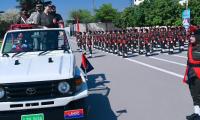Karachi
During the last three years, Sindh has consistently remained the most violence-hit province in the country, with thousands of killings in its capital, Karachi, a security think tank said in its report released on Sunday.
However, because of the Rangers-led ongoing crackdown against criminals, the first quarter of 2016 saw a significant decrease in the number of murders reported in the province, especially in Karachi, the Centre for Research and Security Studies (CRSS), an Islamabad-based security think tank, stated in its report.
Against 368 fatalities in first quarter of 2015, there were 152 fatalities during this period of 2016, a massive decline by any standards.
The drop in violence was not recorded in Karachi alone; and other districts in the province saw a similar trend too.
In the first quarter of the ongoing year, the number of deaths deceased from 291 to 140 in Karachi.
Shikarpur district also saw a significant decrease in deaths from 63 to five during the period.
Over 60 people were killed in a suicide attack on an imambargah in Shikarpur in January last year.
With the exception of a grenade attack, no incidents of suicide attacks or bomb blasts were reported in Sindh during the first quarter of year.
Most of the fatalities resulted from security operations or target killings.
Of the 107 victims of the security operation, 42 belonged to banned militant organisations including the Tehreek-e-Taliban Pakistan, the Lashkar-e-Jhangvi/al-Qaeda in the Indian Subcontinent (AQIS) and the Islamic State (Daesh).
After Fata, Sindh was the only province in the country where the fatalities of non-combatants came down significantly – from 60 percent in the first quarter of 2015 to 30 percent in first quarter of 2016.
At no time during the last three years has Sindh observed such a steep drop in violence-related fatalities.
Law and order situation
The first quarter data on violence-related casualties (both fatalities and injuries) showed an overall decline when compared with the data of the first quarter of 2015.
The CRSS stated in the report that 872 people were killed in this quarter and 573 others injured.
This is a decrease of 36.8 percent in comparison with 1,360 deaths in the first quarter of 2015,.
Despite this overall decline, the first quarter of 2016 showed a nearly 10 percent increase in violence-related fatalities when compared with the fourth quarter of 2015.
Additionally, militants, insurgents and criminals accounted for 68 percent of all fatalities in the first quarter of 2015, which has dropped to 54 percent in the first quarter of 2016.
Conversely, fatalities of non-combatants (civilians, security officials, and government officials) rose from 32 percent in the first quarter of 2015 to 46 percent in the first quarter of 2016.
Focus shifted to Punjab
Despite a continuous decline in violence in the country both annually and quarterly, the first quarter of 2016 saw a slight upsurge, particularly in the Punjab, when compared with the fourth quarter of 2015.
Following a horrific bombing in Punjab’s capital Lahore on March 27 that left 72 dead, many of them Christians celebrating Easter, the focus of the anti-extremism drive shifted to Punjab, it was observe in the report.
This is more than a 100 percent rise in the number of fatalities compared with the first quarter of 2015.
The highest escalation in violence was recorded in Lahore.
Despite an increase in the number of fatalities, the number of affected districts fell from 24 in the first quarter of 2015 to 19 in the first quarter of 2016.
Many districts of southern Punjab (Bahawalpur, Multan, Muzaffargarh, and Bhakkar) witnessed a significant increase in the number of fatalities during the period under review.



This photograph shows commuters driving on a busy street in Karachi. — AFP/FileFrom the River to the SeaThe Sanat...
The Sindh High Court Hyderabad Registry. — Facebook/Sindh High Court Hyderabad HYDERABAD: The Sindh High Court ...
The screenshot shows a memorandum of understanding being singed between the National Highways and Motorway Police and...
Representational image of police tape at an incident site. — Unsplash/FileA local councillor who was wounded during...
In this screengrab, Sindh police chief Ghulam Nabi Memon chairs a meeting on March 25, 2024. — Facebook/Sindh...
Mervyn Francis Lobo, chief executive officer of the Marie Adelaide Leprosy Centre can be seen with Dr. Ruth Pfau ....







